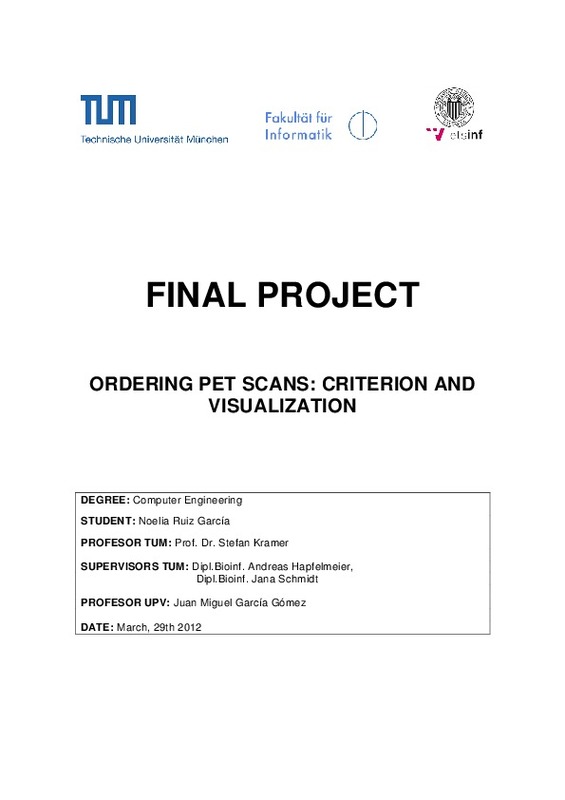JavaScript is disabled for your browser. Some features of this site may not work without it.
Buscar en RiuNet
Listar
Mi cuenta
Estadísticas
Ayuda RiuNet
Admin. UPV
Ordering pet scans: criterion and visualization
Mostrar el registro sencillo del ítem
Ficheros en el ítem
| dc.contributor.advisor | García Gómez, Juan Miguel
|
es_ES |
| dc.contributor.advisor | Kramer, Stefan
|
es_ES |
| dc.contributor.author | Ruiz García, Noelia
|
es_ES |
| dc.date.accessioned | 2012-06-08T11:50:14Z | |
| dc.date.available | 2012-06-08T11:50:14Z | |
| dc.date.created | 2012-05-28 | |
| dc.date.issued | 2012-06-08 | |
| dc.identifier.uri | http://hdl.handle.net/10251/16015 | |
| dc.description.abstract | Neurodegenerative diseases describe a set of diseases caused by abnormalities while certain proteins are processed. These proteins accumulate in the nerve tissue and produce clinical manifestations. The main manifestation is Dementia. The most common type of dementia is Alzheimer's disease, which affects 50-80% of the population [1]. Currently, this type of dementia is considered incurable and irreversible. For this reason, it is important to know all the information about this disease, so the more information we have, the better solution we can find and maybe with the passage of the time this disease can be curable and reversible. The technique PET can detect this type of diseases during the patient¿s life. Furthermore, by means of this technique it has been observed that these diseases have several kinds of patterns according to the brain metabolism degradation. Normally, when a brain is affected by this kind of disease, the brain metabolism degradation begins in a specific area of the brain, but as the disease progresses this area can get bigger or affect other areas of the brain. The goal of this thesis is to analyze a set of PET scans from several people who have some kind of neurodegenerative disease, such as, Mild Cognitive Impairment (MCI) and Alzheimer's Disease (AD). This analysis will allow us to obtain an order among the PET scans according to the affected areas in the brain, and will show the brain metabolism degradation in the development of Alzheimer's disease. This order will be represented by an acyclic directed graph (ADG) that it will be visualized in an application. This application will get the set of PET scans and it will obtain the corresponding graph which will show the order of PET scans. Furthermore, in each node we will display complementary information about each PET scan. This application, it will not be used only by computer experts but also by unskilled users, in future studies about neurodegenerative diseases, in particular, about Alzheimer's disease. | es_ES |
| dc.format.extent | 106 | es_ES |
| dc.language | Inglés | es_ES |
| dc.publisher | Universitat Politècnica de València | es_ES |
| dc.rights | Reserva de todos los derechos | es_ES |
| dc.subject.other | Ingeniería Informática-Enginyeria Informàtica | es_ES |
| dc.title | Ordering pet scans: criterion and visualization | es_ES |
| dc.type | Proyecto/Trabajo fin de carrera/grado | es_ES |
| dc.rights.accessRights | Abierto | es_ES |
| dc.contributor.affiliation | Universitat Politècnica de València. Escola Tècnica Superior d'Enginyeria Informàtica | es_ES |
| dc.description.bibliographicCitation | Ruiz García, N. (2012). Ordering pet scans: criterion and visualization. http://hdl.handle.net/10251/16015. | es_ES |
| dc.description.accrualMethod | Archivo delegado | es_ES |
Este ítem aparece en la(s) siguiente(s) colección(ones)
-
ETSINF - Trabajos académicos [4804]
Escola Tècnica Superior d'Enginyeria Informàtica






